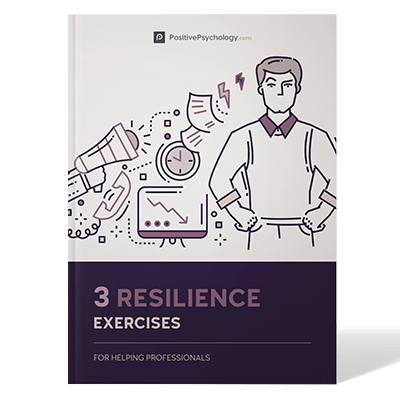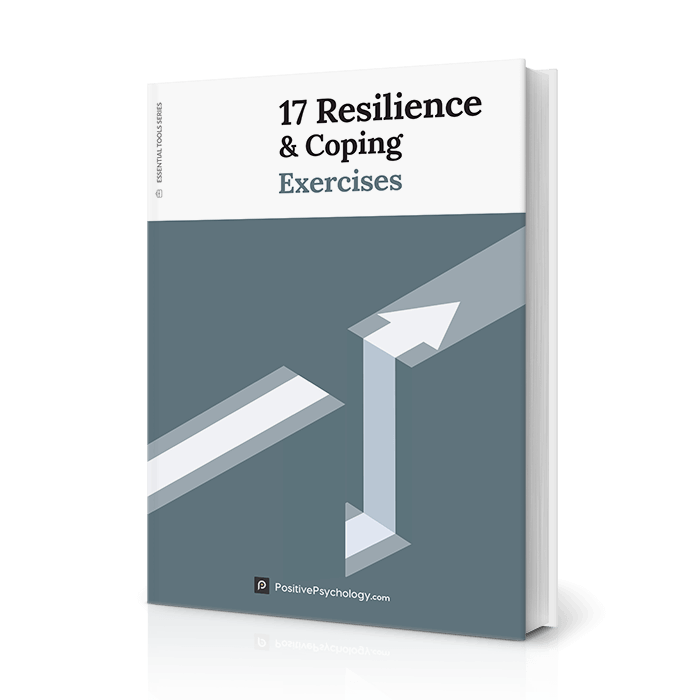6 Scales to Measure Coping + The Brief Cope Inventory
 Sometimes life seems to pile up all at once.
Sometimes life seems to pile up all at once.
We find ourselves juggling a multitude of daily challenges, large and small, or unexpected events that send our anxiety or stress responses into a tailspin.
When this happens, it can be difficult to take a moment to check-in and see how we’re really coping. We might think we’re doing okay and participating in supportive behaviors, but how accurate is that really? And how do we reflect adequately to address where we might be indulging in behaviors that are counterintuitive to help us cope effectively?
As ever, positive psychology might hold the tools and resources that can help us. One type of resource you can tap into are scales for measuring coping.
Before you read on, we thought you might like to download our three Resilience Exercises for free. These engaging, science-based exercises will help you to effectively cope with difficult circumstances and give you the tools to improve the resilience of your clients, students or employees.
This Article Contains:
- What Do Coping Questionnaires Measure Exactly?
- A Look at the Reliability and Validity
- The COPE Inventory
- The Carver Brief COPE Inventory (+PDF)
- The Coping Self-Efficacy Scale (CSES)
- The Brief Resilient Coping Scale (BRCS)
- The Proactive Coping Inventory (PCI)
- The Dyadic Coping Inventory (DCI)
- A Take-Home Message
- References
What Do Coping Questionnaires Measure Exactly?
Coping questionnaires aim to measure your coping strategies and ability to self-regulate in response to different experienced stressors.
Perhaps when we’re trying to understand what coping questionnaires measure, a good place to start is by understanding what we mean by ‘coping.’
According to Gurvich et al. (2021) coping is making use of mechanisms intended to reduce psychological stress. These mechanisms could be good or bad, some effective and some less so, as an example, consider emotional eating or smoking, versus seeking emotional support from friends or building resilience.
Individual behaviors relating to coping can be challenging to measure, as we respond differently to the same type of stressor, depending on several different factors including our character traits, specific environment, support networks, and individual life experiences.
How we cope as individuals may also change as we develop, and just because we respond to one scenario in one way, doesn’t mean we’ll react to it the same way if it happens again.
Coping questionnaires are helping us to understand our coping strategies at any given moment towards different situations in our lives. Coping strategies can be positive, for example, tapping into your social support network, or negative, such as turning to alcohol or drugs.
A Look at the Reliability and Validity
Most of the research on coping is divided into exploring two key areas: coping styles or coping strategies. While they seem similar, there is a core distinction between the two:
Coping Styles
Coping style refers to your disposition towards handling challenging situations or stressors. Endler and Parker (1990) suggested that there are three basic coping styles: task-oriented, emotion-oriented, and avoidance-oriented. Your coping style may stay consistent across different situations and experiences, and the coping strategies you use within this may change and adapt.
Research into coping styles has received a fair amount of criticism. The main criticism is that that in focusing only on coping styles, the variability and complexity of coping efforts overall are not captured effectively, and stifles predictive validity within the research (Lazarus and Folkman, 1984).
The researchers argue that a better evaluation and validity can be developed by focusing on coping strategies within specific contexts, rather than how someone copes with stress generally.
Coping Strategies
Studies that use coping scales or measurements focused on measuring coping strategies for specific situations or stressors have been found to be more valid and reliable (Daniels and Harris, 2005, Lazarus and Folkman, 1984).
Greenaway et al. (2015) conducted a review of 6 different coping measures. They found that overall, these types of measures tended to have higher validity, but some tests had poorer test-retest reliability than others (specifically The Ways of Coping Questionnaire).
One of the main criticisms for the validity and reliability of coping scales and measures for coping strategies is that they ask participants to recall stressful experiences or respond to hypothetical situations that fail to measure ‘in the moment’ coping responses (Porter and Stone, 1996, Steptoe, 1989).
Overall, researchers agree there is some weakness to these measurements; however, they can still be a great tool and resource. Greenaway et al. (2015) summarised that low to moderate inconsistencies with coping measures should not deter their use, but that researchers need to be rigorous in selecting the scales or questionnaires they use with their particular participant groups.
The COPE Inventory
The COPE inventory was created by Carver et al. (1989). It is a multi-dimensional inventory developed to asses the different coping strategies people use in response to stress. COPE stands for Coping Orientation to Problems Experienced.
The inventory is a list of statements that participants review and score. There are two main components to the COPE inventory: problem-focused coping and emotion-focused coping.
Five scales aim to measure each of these:
Problem-focused coping
- Active Coping
- Planning
- Suppression of Competing Activities
- Restraint Coping
- Seeking of Instrumental Social Support
Example statements from the inventory include ‘I concentrate my efforts on doing something about it’ and ‘I take additional action to try to get rid of the problem.’
Emotion-focused coping
- Seeking of Emotional Social Support
- Positive Reinterpretation
- Acceptance
- Denial
- Turning to Religion
Example statements from the inventory include ‘I discuss my feelings with someone’ and ‘I seek God’s help.’
It also contains three scales aimed at measuring coping responses:
- Focus on and Venting of Emotions
- Behavioral Disengagement
- Mental Disengagement
Example statements from the inventory include ‘I get upset and let my emotions out’ and ‘I get upset, and am really aware of it.’
How Does Scoring Work?
To score the COPE Inventory, you need to first respond to each of the statements with a score from 1 to 4, as follows:
1 = I usually don’t do this at all
2 = I usually do this a little bit
3 = I usually do this a medium amount
4 = I usually do this a lot
Each statement in the inventory is then connected to a specific coping strategy that sits under either the problem-focused, emotion-focused, or coping response measures. Your scores will inform you which form of coping strategy you are more engaged in.
For example, Active Coping in the inventory is measured with the following four statements:
- I concentrate my efforts on doing something about it.
- I take additional action to try to get rid of the problem.
- I take direct action to get around the problem.
- I do what has to be done, one step at a time.
If you were to give these statements higher scores – such as a 3 or 4 – you would score highly as using Active Coping as one of your coping strategies. If you scored low – with a 1 or 2 – then Active Coping would not be one of your core coping strategies.
This scoring can help you ascertain which measures are your most reliable coping strategies from the different ones utilized in the inventory.
Access a full copy of the COPE Inventory, including scoring.
The Carver Brief COPE Inventory (+PDF)
One of the challenges and criticisms of the COPE Inventory was its length. The Brief COPE Inventory was adapted by Carver (1997) and is an abbreviated version of the full COPE Inventory.
The Brief COPE Inventory consists of only 28 statements, across two scales, and is more focused on understanding the frequency with which people use different coping strategies in response to various stressors. Participants using the inventory, score themselves from 1 to 4 with 1 being ‘I haven’t been doing this at all’ and 4 being ‘I’ve been doing this a lot.’
Statements from the scale include things like:
- I’ve been turning to work or other activities to take my mind off things.
- I’ve been concentrating my efforts on doing something about the situation I’m in.
- I’ve been saying to myself, “this isn’t real.”
Download the full Brief Cope Inventory and scoring instructions.
What are the 4 types of coping mechanisms – Mended Light
The Coping Self-Efficacy Scale (CSES)
Similar to the COPE Inventory, the Coping Self-Efficacy Scale (CSES) was created to measure an individual’s confidence in their coping strategies when it comes to handling challenges and stressors.
It was authored by Chesney et al. (2006) in partnership with Dr. Albert Bandura from Stanford University and initially developed for use with staff and patients at the Center for AIDS Prevention Studies at the University of California, San Francisco.
The CSES contains 26 items which are prefaced by the statement ‘When things aren’t going well for you, or when you’re having problems, how confident are you that you can do the following.’
Example statements include things like:
- Make new friends.
- Do something positive for yourself when you are feeling discouraged.
- Make unpleasant thoughts go away.
- Think about one part of the problem at a time.
How Does Scoring Work?
Participants using the scale are asked to give each of the 26 statements a personal score from 0 to 10 as follows:
0 = Cannot do at all
5 = Moderately confident I can do
10 = Certain I can do
A final score is created by summing all of the individual scores. A higher score indicates a high level of self-efficacy when it comes to implementing positive coping strategies. A lower score indicates a lower level of self-efficacy.
If you are interested in obtaining a copy of the scale, please email the author, Dr. Margaret Chesney to request permission at margaret.chesney@ucsf.edu.
The Brief Resilient Coping Scale (BRCS)
The Brief Resilient Coping Scale (BRCS) is an even shorter measure of resilient coping, designed by Sinclair and Walston (2004), to capture an individual’s ability to cope with stress in highly adaptive ways.
When the researchers say brief – they mean brief! The measure contains only four statements, that participants rate from 1 (Does not describe me at all) to 5 (Describes me very well).
After giving each of the four statements a score, participants sum up their responses for a final score. A high score – between 17 and 20 – indicates that you are a highly resilient coper, and a low score – between 4 and 13 – suggests that you are a low resilient coper.
Access the Brief Resilient Coping Scale, including scoring.
The Proactive Coping Inventory (PCI)
The Proactive Coping Inventory (PCI) was developed by Greenglass and Schwarzer (1998). The PCI was created to measure different proactive approaches to coping and contains seven subscales to achieve this:
- Proactive Coping
- Preventive Coping
- Reflective Coping
- Strategic Planning
- Instrumental Support Seeking
- Emotional Support Seeking
- Avoidance Coping
There are 55 statements in total in the inventory, and participants are asked to give each statement a score between 1 (Not at all true) and 4 (Completely true). Example statements include:
- I like challenges and beating the odds.
- I visualize my dreams and try to achieve them.
- Despite numerous setbacks, I usually succeed in getting what I want.
- I try to pinpoint what I need to succeed.
The statements are grouped by the subscale they relate to (so the examples above all relate to the Proactive Coping subscale) and then totals are used to ascertain which subscales of coping you use the most.
Access the full Proactive Coping Inventory, including scoring.
The Dyadic Coping Inventory (DCI)
The Dyadic Coping Inventory (DCI) was created by Bodenmann (2008) and is slightly different from the other scales mentioned in this article in that it was specifically developed to be used within close relationships, for when one or both partners are experiencing stress.
It contains 37 statements that aim to measure communication and dyadic coping. Dyadic coping relates closely to partners in close relationships and strategies include:
- Supportive
- Delegated
- Negative
- Joint
Dyadic coping also involves:
- One partner’s attempt to reduce the stress of the other partner.
- A joint effort from both partners to deal with stress that may impact their relationship.
The DCI contains six subscales that ask each person to reflect on how they communicate stress to their partner, how their partner responds, how their partner communicates they are stressed, how they react to their partner’s stress, how they behave when both partners are stressed, and how you cope as a couple.
Example statements include:
- When my partner feels he/she has too much to do, I help him/her out.
- When my partner is stressed, I tend to withdraw.
- We help one another to put the problem in perspective and see it in a new light.
Each statement is given a score between 1 (Very rarely) and 4 (Very often). Higher scores reflect higher dyadic coping for each of the subscales.
Access to the full Dyadic Coping Inventory, including scoring instructions.
A Take-Home Message
This is only the tip of the iceberg when it comes to coping scales and questionnaires! There have been many more developed that aim to provide insights for specific challenges and stressors that may be experienced by individuals, as well as scales that can be used with different groups – including young children and teenagers.
If there’s one thing I’d like you to take away from this article, it’s that our coping strategies and styles can develop and change over time, as we grow, learn and develop through our experiences.
Coping scales are a great way to understand further your ways of coping at one point in time, and should be revisited often so you can develop an on-going relationship with your coping styles and reflect on how you might be able to improve.
Have you used any coping scales or questionnaires yourself? I’d love to hear about your personal experiences in the comments.
We hope you found this article useful. Don’t forget to download our three Resilience Exercises for free.
- Bodenmann, G. (2008). Dyadisches Coping Inventar: Testmanual [Dyadic Coping Inventory: Test manual]. Bern, Switzerland: Huber.
- Carver, C. S., Scheier, M. F., & Weintraub, J. K. (1989). Assessing coping strategies: a theoretically based approach. Journal of personality and social psychology, 56(2), 267.
- Carver, C. (1997). You want to measure coping but your protocol’s too long: Consider the brief COPE. International Journal of Behavioural Medicine, 4
- Chesney, M. A., Neilands, T. B., Chambers, D. B., Taylor, J. M., Folkman, S. (2006). A validity and reliability study of the coping self-efficacy scale. Retrieved from: https://www.ncbi.nlm.nih.gov/pmc/articles/PMC1602207/
- Endler, N. S., & Parker, J. D. A. (1990). Multidimensional assessment of coping: A critical evaluation. Journal of Personality and Social Psychology, 58.
- Daniels, K., and Harris, C. (2005). A daily diary study of coping in the context of job demands-control-support model. Journal of Vocational Behavior, 66.
- Greenaway, K., Louis, W. R., Parker, S. L., & Kalokerinos, E. (2015). Measures of Coping for Psychological Well-Being. Retrieved from: https://www.researchgate.net/publication/282566883_Measures_of_Coping_for_Psychological_Well-Being
- Greenglass, E. & Schwarzer, R. (1998). The Proactive Coping Inventory (PCI). In R. Schwarzer (Ed.), Advances in health psychology research (CD-ROM). Berlin: Free University of Berlin.
- Gurvich, C., Thomas, N., Thomas, E. H., Hudaib, A. R., Sood, L., Fabiatos, K.,Sutton, K., Isaacs, A., Arunogiri, S., Sharp, G., & Kulkarni, J. (2021). Coping styles and mental health in response to societal changes during the COVID-19 pandemic. International Journal of Social Psychiatry, 67(5), 540-549.
- Lazarus, R., & Folkman, S. (1984). Stress, appraisal, and coping. New York: Springer.
- Porter, L. & Stone, A. (1996). An approach to assessing daily coping. In Zeidner, M. and Endler, N. (Eds). Handbook of Coping: Theory, Research, and Applications. Oxford, UK.
- Sinclair, V. G., & Wallston, K.A. (2004). The development and psychometric evaluation of the Brief Resilient Coping Scale. Retrieved from: https://www.ncbi.nlm.nih.gov/pubmed/14994958
- Steptoe, A. (1989). An abbreviated version of the Miller Behavioral Style Scale. British Journal of Clinical Psychology, 28.
Let us know your thoughts
Read other articles by their category
- Body & Brain (49)
- Coaching & Application (57)
- Compassion (26)
- Counseling (51)
- Emotional Intelligence (24)
- Gratitude (18)
- Grief & Bereavement (21)
- Happiness & SWB (40)
- Meaning & Values (26)
- Meditation (20)
- Mindfulness (45)
- Motivation & Goals (45)
- Optimism & Mindset (34)
- Positive CBT (28)
- Positive Communication (20)
- Positive Education (47)
- Positive Emotions (32)
- Positive Leadership (18)
- Positive Parenting (4)
- Positive Psychology (33)
- Positive Workplace (37)
- Productivity (16)
- Relationships (46)
- Resilience & Coping (36)
- Self Awareness (21)
- Self Esteem (38)
- Strengths & Virtues (32)
- Stress & Burnout Prevention (34)
- Theory & Books (46)
- Therapy Exercises (37)
- Types of Therapy (64)





What our readers think
Dear Ma’am/Sir,
I am May A. Gales, a third-year student at Liceo de Cagayan University from the Philippines. I am writing to ask for permission to utilize the Brief COPE scale in my research.
My study aims to determine the anxiety prevalence and positive and negative coping mechanisms of CRS students at Liceo de Cagayan University. I would like to put into utilization of the Carver, C.S., Brief COPE scale. (1997) for the gathering of data for my research. My research findings will be far more valid and reliable if I use the Brief COPE scale, a widely recognized tool for evaluating coping mechanisms across a range of populations.
I am requesting official permission to use the Brief COPE scale in my research study because I am aware that it is copyrighted information. I guarantee that the scale will not be distributed or duplicated for profit; it will only be used for research.
As per the guidelines provided by your institution, I guarantee to correctly cite the Brief COPE scale’s source in any papers or presentations that arise from my study.
Sincerely,
May A. Gales
Student Researcher
Hi May,
This scale is freely available to use and a copy of it with scoring information can be accessed here.
Hope this helps!
Warm regards,
Julia | Community Manager
Hello ma’am, I am planning on conducting a research on the impact of Discrimination, Social Support and Coping Strategies on Psychological well-being. I particularly want to use coping strategies as a intermediate variable and see their influence on psychological well-being. My chosen population is ethnic/racial minorities who are all emerging adults in an urban, Indian setting. Would the Brief Cope Inventory be suitable for such a study?
Hi there,
The Brief COPE Inventory is a widely used tool for assessing a broad range of coping strategies in response to stressors. Developed by Charles Carver, it is a condensed version of the COPE Inventory and has been employed in numerous studies across diverse populations and settings.
Given the nature of your research the Brief COPE Inventory may indeed be suitable!
While there is limited information available regarding the cultural appropriateness of the Brief COPE Inventory for an Indian population, I recommend reaching out to the developer, Charles Carver, of the inventory or exploring other studies that might offer more insights on its relevance and applicability in this context.
Warm regards,
Julia | Community Manager
respected madam, i am a student of master in Nursing studying in Patan Acadeny of Health sciences (PAHS) in Nepal . i am going to conduct the research on the topic “self esteem and coping strategies among adolescents in kathmandu valley.” i am willing to use brief cope in my research. i want to know the criteria of using this tool..and want permission to use this tool. i am looking forward to to you for your positive response…. thank you
Hi Niva,
are you referring to the “Brief COPE Inventory” or the “Brief Resilient Coping Scale”?
Let me know so I can help you further 🙂
Kind regards,
Julia | Community Manager
Thanks for the article. I think the Brief COPE inventory perfectly suits my research that I am doing. Can you please tell me if I can use the downloaded inventory in Google Forms and if there are any copyright procedures that I must follow? Thanks
Hi Shalini,
I’m glad you found the article helpful, and it’s great to hear that the Brief COPE inventory is a good fit for your research!
You can definitely use the downloaded inventory in Google Forms, but I would definitely add the reference of the author, Carver (1997), to your Google Forms.
Hope this helps!
Kind regards,
Julia | Community Manager
Hi, Im a msc nursing student. I need to assess coping strategies of IT employees so brief cope will be appropriate for this?
Is brief-COPE standaridized scale?
Hi Swapna,
Yes, the Brief-COPE is a standardized scale!
In case you have any other questions or need additional details about the scale, please don’t hesitate to ask.
We’re more than happy to help!
Kind regards,
Julia | Community Manager
Hi Swapna,
Yes, the Brief COPE can be used across various populations and professions, including IT employees, as it measures general coping strategies that are not specific to a particular profession.
Hope this helps!
Kind regards,
Julia | Community Manager
Dearest Ma’am and Sir,
Greetings!
I am Christel Rhea G. Lachica, a licensed teacher, who teaches at Montessori De Manila in the Grade School Department. I am currently enrolled at Pamantasan ng Muntinlupa as a Graduate Student taking up Master of Arts in Education, Major in Guidance and Counseling. I am presently working with my Thesis Writing entitled, “Parenting Stress, Coping Strategies, and Self-Efficacy of Parent Teachers in Montessori De Manila Amidst Pandemic toward Guidance Intervention Program”
I am writing this letter to humbly ask your permission if I may use the Brief COPE Inventory for my Thesis Writing.
In line with this, I would love to use the research instruments. I am aware that you own all rights in your article and that is why it is best to ask permission before using it. With regard to this I want to assure you that you will be definitely credited as the source and the original writer of the article.
Looking forward to your kind understanding and consideration. Thank you so much and God bless you all!
Respectfully yours,
Christel Rhea G. Lachica
Hello Christel,
Thank you for your question. You do not need to obtain special permission to use this scale, as it is free to use for research purposes 🙂
Good luck!
Kind regards,
-Caroline | Community Manager
Hi I’m currently doing my research but I’m still confused what Test I should use in Coping mechanism in terms of Emotional, social, and behavioral aspects… do you have any suggestion and who and where can I ask consent for those test???
Hi Shan,
Thanks for your question. The scales outlined in this article are free to use for research purposes, so acquiring additional permission from the scale developer or lead researcher is not required. Regarding your question on which assessment to use, I would need to know more information about your variables, theoretical framework, and target population to help you more 🙂
I hope this helps!
Kind regards,
-Caroline | Community Manager
My research is all about Psychological Well-Being of Workers Deprived of Sleep…. During our proposal in research one of the panel approved Glasser of Choice Theory then asked to add Albert Bandura Self-Efficacy Theory and also a theory about sleep deprivation, but i don’t know any theory about it even until now…. my target of course is workers with shift at night to morning, my research adviser said to choose one so I picked BPO workers but the things is it was quite challenging to find those who work at BPO…
i am currently doing a research on coping strategies on academic burden ,can i get recommendation on which tool should i will be using
A very useful article! Thank you so much for this <3
A very useful article, I am a post graduate student , doing M.SC in Nursing. I am doing a study on the parents of children with congenital heart disease to assess stress and coping among the parents. what tool should be applicable to assess coping strategies of parents in my study. Please suggest.
thank you
Hi Arpana,
Thanks for your question. I think the Parental Stress & Coping Inventory or the Parental Coping Scale would be most suitable for your research.
Good luck!
Kind regards,
-Caroline | Community Manager